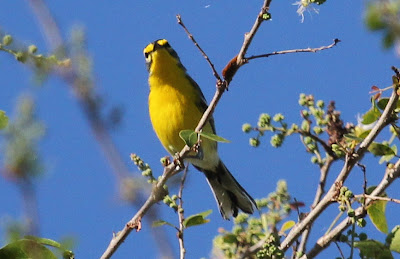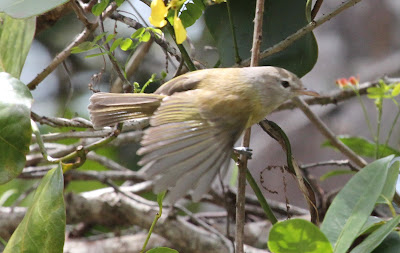The Puerto Rican Tanager is another bird that is endemic to the island. This was another that was fairly difficult to photograph (it just wouldn't cooperate), but I did manage to get a few.
The body plumage of the Puerto Rican Tanager is mostly olive brown, with white underparts and a white wing spot.
Saturday, March 31, 2012
Friday, March 30, 2012
Day 90: Masked Duck
When I first spotted Masked Ducks at a lagoon in southwest Puerto Rico, I didn't know what I had found. "Jared, come look at these little ducklings!" I had said. "You can barely see them, they're all hiding in the marsh!"
Turns out, they were not ducklings, but rather the tiny stiff-tailed Masked Duck. They were pretty far away, which was disappointing, but it was still great to see such an interesting little bird.
Masked Ducks can be found from Mexico to South America and the Caribbean. On the rare occassion, they will be reported as a vagrant in the southernmost U.S. They are usually very secretive, which was evident to us, as they were hiding in the marsh plants. Masked Ducks feed by diving for aquatic plants, insects, and crustaceans.
Here's a photo of a Masked Duck up close, which unfortunately isn't mine (and it's also in breeding plumage, which is different from the birds that we saw):
Turns out, they were not ducklings, but rather the tiny stiff-tailed Masked Duck. They were pretty far away, which was disappointing, but it was still great to see such an interesting little bird.
Lots of little Masked Ducks hiding in the weeds...
Masked Ducks can be found from Mexico to South America and the Caribbean. On the rare occassion, they will be reported as a vagrant in the southernmost U.S. They are usually very secretive, which was evident to us, as they were hiding in the marsh plants. Masked Ducks feed by diving for aquatic plants, insects, and crustaceans.
Here's a photo of a Masked Duck up close, which unfortunately isn't mine (and it's also in breeding plumage, which is different from the birds that we saw):
Thursday, March 29, 2012
Day 89: Puerto Rican Spindalis
The Puerto Rican Spindalis is a type of tanager that is endemic to the island of Puerto Rico. It can be found throughout much of the island and is important to the ecosystem, helping with seed dispersal and plant reproduction.
Male birds are brightly colored with an orange neck and chest. They have a black head with two white stripes, one above and one below the eyes. Females are a dull olive color.
We saw several Puerto Rican Spindalis's on our trip, and a few even visited us by the porch of our hotel.
Male birds are brightly colored with an orange neck and chest. They have a black head with two white stripes, one above and one below the eyes. Females are a dull olive color.
We saw several Puerto Rican Spindalis's on our trip, and a few even visited us by the porch of our hotel.
Wednesday, March 28, 2012
Day 88: Zenaida Dove
You might recall my general distaste for doves (particularly Mourning Doves) from an earlier post. However, I have to admit, today's bird was a pleasant addition to our Puerto Rico trip.
The Zenaida Dove breeds throughout the Caribbean and part of the Yucatan Peninsula. It look fairly similar to the Mourning Dove that we are used to her in the U.S., except that it has darker plumage, a shorter, more rounded tail, and is a bit smaller in size.
We saw several Zenaida Doves during our visit to Puerto Rico.
The Zenaida Dove breeds throughout the Caribbean and part of the Yucatan Peninsula. It look fairly similar to the Mourning Dove that we are used to her in the U.S., except that it has darker plumage, a shorter, more rounded tail, and is a bit smaller in size.
We saw several Zenaida Doves during our visit to Puerto Rico.
Tuesday, March 27, 2012
Day 87: Orange Bishop
The Orange Bishop is an African native that was introduced to Puerto Rico. It's a type of weaver (a bird related to a finch).
The male Orange Bishop goes through a dramatic plumage transformation each breeding season, with bright orange and black feathers. Unfortunately for us, we were in Puerto Rico before breeding season, so the Orange Bishops still had dull brown plumage. We saw lots of orange bishops around the lagoon in southwest Puerto Rico.
Here's a picture of a male Orange Bishop in its full breeding plumage (not my photo):
The male Orange Bishop goes through a dramatic plumage transformation each breeding season, with bright orange and black feathers. Unfortunately for us, we were in Puerto Rico before breeding season, so the Orange Bishops still had dull brown plumage. We saw lots of orange bishops around the lagoon in southwest Puerto Rico.
Here's a picture of a male Orange Bishop in its full breeding plumage (not my photo):
Monday, March 26, 2012
Day 86: Mangrove Cuckoo
The Mangrove Cuckoo is one of my favorite birds that we saw during our trip. They are fairly large birds with tan underparts, a black mask, and a long black tail with white spots. We saw several on our trip, but one especially close was snacking on some bugs in a tree.
Mangrove Cuckoos have a really interesting guttural call that we learned to identify pretty quickly while hiking around.
Another cuckoo that I really wanted to see is the Puerto Rican Lizard-Cuckoo, which is endemic to the island. Unfortunately, I heard them call several times, but never got the opportunity to see or photograph one. We went hunting for one on a hot, sunny afternoon, and finally found one close to the trail at the very end of a long hike. It responded really well when Jared played its call on his phone, so we were able to sneak closer and closer. Jared actually caught a glimpse of it, but I got too excited and scared it off when I rushed over to see it. Major bummer.
Mangrove Cuckoos have a really interesting guttural call that we learned to identify pretty quickly while hiking around.
Another cuckoo that I really wanted to see is the Puerto Rican Lizard-Cuckoo, which is endemic to the island. Unfortunately, I heard them call several times, but never got the opportunity to see or photograph one. We went hunting for one on a hot, sunny afternoon, and finally found one close to the trail at the very end of a long hike. It responded really well when Jared played its call on his phone, so we were able to sneak closer and closer. Jared actually caught a glimpse of it, but I got too excited and scared it off when I rushed over to see it. Major bummer.
Sunday, March 25, 2012
Day 85: Green-throated Carib
One of the first birds we tried to go see on our trip was the Green-throated Carib, a beautiful hummingbird that breeds in eastern Puerto Rico. Since we were staying at the far west of the island for the majority of our trip, we decided to wake up super early our first day to take a quick drive out east. We knew that if we drove around looking for flowering bushes and trees, there was a decent chance that we would find a Green-throated Carib.
After a bit of searching and waiting, we finally spotted a hummingbird on a stretch of road with lots of bright flowers, and realized it was the Green-throated Carib! Though I didn't get great photos, it was really fun to watch it for a while. They are green on top with a black belly and a bright, iridescent green throat and breast. At the right angle, you can see a thin blue line bordering the green breast and black belly.
After a bit of searching and waiting, we finally spotted a hummingbird on a stretch of road with lots of bright flowers, and realized it was the Green-throated Carib! Though I didn't get great photos, it was really fun to watch it for a while. They are green on top with a black belly and a bright, iridescent green throat and breast. At the right angle, you can see a thin blue line bordering the green breast and black belly.
Saturday, March 24, 2012
Day 84: Adelaide's Warbler
The Adelaide's Warbler is a pretty little warbler that is endemic to Puerto Rico. We first spotted one while hiking to a lagoon in the southwest part of the island, but ended up seeing several during our trip.
The Adelaide's Warbler is grey on top with a yellow breast and throat. We often heard one singing before spotting it.
The Adelaide's Warbler is grey on top with a yellow breast and throat. We often heard one singing before spotting it.
Friday, March 23, 2012
Day 83: Puerto Rican Vireo
One bird on our "most wanted" list during our trip is an endemic species to Puerto Rico, the Puerto Rican Vireo. I have to say, this little bird made me WORK for a photo, and I didn't even end up with a great one. We found the vireo at the end of a long day of birding, so I was already tired lugging the camera around. Of course, the bird was not content to pose for me out in the open. Instead, it flew back and forth in some bushes, scrambling twig to twig, barely pausing long enough for me to move my camera. After what felt like an eternity of chasing the darn thing (which was probably only 5 minutes), I managed to snap a couple of somewhat okay shots. I'm glad to have gotten something for my efforts, at least, unlike a few birds that I will post about later with no photos.
The Puerto Rican Vireo has a gray head, a white breast and a yellowish belly. They mostly eat insects and berries.
Eluding me again....
The Puerto Rican Vireo has a gray head, a white breast and a yellowish belly. They mostly eat insects and berries.
Thursday, March 22, 2012
Day 82: Smooth-billed Ani
We saw several Smooth-billed Ani's by a lagoon that we visited in Puerto Rico. These striking black birds have long tails and large, deep ridged black bills. They mainly eat insects, fruit, and seeds.
Smooth-billed Ani's breed in south Florida, the Caribbean, and parts of Central and South America. This is the second species of ani we've seen in recent years; we saw the smaller Groove-billed Ani in south Texas.
Smooth-billed Ani's breed in south Florida, the Caribbean, and parts of Central and South America. This is the second species of ani we've seen in recent years; we saw the smaller Groove-billed Ani in south Texas.
Wednesday, March 21, 2012
Day 81: Bananaquit
I love today's bird because they have such a fun name. Bananaquits are colorful, frisky little birds that we found all over Puerto Rico (and also on our trip to Costa Rica a few years ago). They make funny little faces when they call, sticking out their tongues. They are also known for their ability to adapt to human environments, which we noticed. They didn't seem to care that we were watching them most of the time.
The curved bill of a Bananaquit is used to take nectar from flowers, which they eat. Unlike hummingbirds, which can hover when they eat, Bananaquits are large enough that they have to perch.
The curved bill of a Bananaquit is used to take nectar from flowers, which they eat. Unlike hummingbirds, which can hover when they eat, Bananaquits are large enough that they have to perch.
Subscribe to:
Posts (Atom)



















































